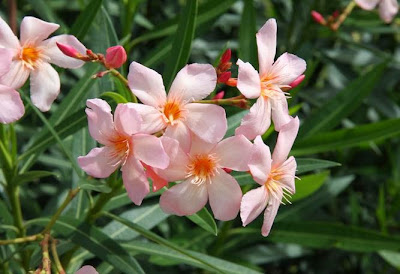Type of Flower
Nerium Oleander:
Nerium oleander is an evergreen shrub or pocket-size tree inwards the dogbane identify unit of measurement Apocynaceae, toxic inwards all its parts. It is the solely species currently classified inwards the genus Nerium. It is close ordinarily known equally oleander, from its superficial resemblance to the unrelated olive Olea.It is hence widely cultivated that no precise percentage of root has been identified, though southwest Asia has been suggested. The ancient metropolis of Volubilis inwards Kingdom of Morocco may conduct keep taken its scream from the Berber scream oualilt for the flower.Oleander is i of the close poisonous of ordinarily grown garden plants.
Oleander grows to 2–6 1000 (6.6–19.7 ft) tall, alongside erect stems that splay outward equally they mature; first-year stems conduct keep a glaucous bloom, piece mature stems conduct keep a grayish bark. The leaves are inwards pairs or whorls of three, thick too leathery, dark-green, narrow lanceolate, 5–21 cm (2.0–8.3 in) long too 1–3.5 cm (0.39–1.38 in) broad, too alongside an entire margin. The flowers grow inwards clusters at the cease of each branch; they are white, pinkish to red, 2.5–5 cm (0.98–1.97 in) diameter, alongside a deeply 5-lobed fringed corolla circular the fundamental corolla tube. They are often, but non always, sweet-scented.The fruit is a long narrow capsule 5–23 cm (2.0–9.1 in) long, which splits opened upwardly at maturity to unloose numerous downy seeds.
Nerium oleander is either native or naturalized to a broad surface area from Mauritania, Morocco, too Portugal eastward through the Mediterranean percentage too the Sahara (where it is solely constitute sporadically), to the Arabian peninsula, southern Asia, too equally far East equally Yunnan inwards southern parts of China.It typically occurs about dry out flow beds. Nerium oleander is planted inwards many subtropical too tropical areas of the world. On the East Coast of the US, it tin locomote live planted equally far due north equally Virginia Beach, Virginia, piece inwards California too Texas it is naturalized equally a median strip planting.
Nerium oleander has historically been considered a poisonous flora because some of its compounds may exhibit toxicity, peculiarly to animals, when consumed inwards high amounts. Among these compounds are oleandrin too oleandrigenin, known equally cardiac glycosides, which are known to conduct keep a narrow therapeutic index too tin locomote live toxic when ingested. Toxicity studies of animals administered oleander extract concluded that rodents too birds were observed to live relatively insensitive to oleander cardiac glycosides.Other mammals, however, such equally dogs too humans, are relatively sensitive to the effects of cardiac glycosides too the clinical manifestations of "glycoside intoxication".
However, despite the mutual "poisonous" designation of this plant, rattling few toxic events inwards humans conduct keep been reported. According to the Toxic Exposure Surveillance System (TESS) inwards 2002 in that place were 847 human exposures to oleander reported to toxicant centers inwards the United States.Despite this exposure level, from 1985 through 2005, solely 3 deaths were reported. One cited decease was evidently due to the ingestion of oleander leaves past times a diabetic man.His blood indicated a full blood concentration of cardiac glycosides of or hence twenty μg/L which is good inwards a higher identify the reported fatal level. Another study reported on the decease of a adult woman who self-administered "an undefined oleander extract" both orally too rectally too her oleandrin tissue levels were 10 to 39 μg/g which were inwards the high gain of reported levels at autopsy And endure i study reported the decease of a adult woman who ingested oleander 'tea'.Few other details were provided.
In contrast to consumption of these undefined oleander derived materials, in that place is no toxicity or deaths reported from topical management or contact alongside Nerium oleander or specific products derived from them. In reviewing oleander toxicity Lanford too Boor[18] concluded that, except for children who mightiness live at greater risk, "the human mortality associated alongside oleander ingestion is to a greater extent than oftentimes than non rattling low, fifty-fifty inwards cases of moderate intentional consumption (suicide attempts)".
Toxicity studies that conduct keep been conducted inwards dogs too rodents administered oleander extracts past times intramuscular (IM) injection indicated that on an equivalent weight basis, doses of an oleander extract alongside glycosides 10 times inwards excess of those probable to live administered therapeutically to humans are silent prophylactic too without whatever "severe toxicity observed".
Reactions to ingestion of this flora tin locomote touching on the gastrointestinal system, the heart, too the fundamental nervous system. The gastrointestinal effects tin locomote consist of nausea too vomiting, excess salivation, abdominal pain, diarrhea that may or may non incorporate blood, too peculiarly inwards horses, colic.[6] Cardiac reactions consist of irregular pump rate, sometimes characterized past times a racing pump at commence that too hence slows to below normal farther along inwards the reaction. Extremities may function pale too mutual depression temperature due to wretched or irregular circulation. The number on the fundamental nervous organisation may present itself inwards symptoms such equally drowsiness, tremors or shaking of the muscles, seizures, collapse, too fifty-fifty coma that tin locomote Pb to death.
Oleander sap tin locomote drive pare irritations, severe oculus inflammation too irritation, too allergic reactions characterized past times dermatitis.
























